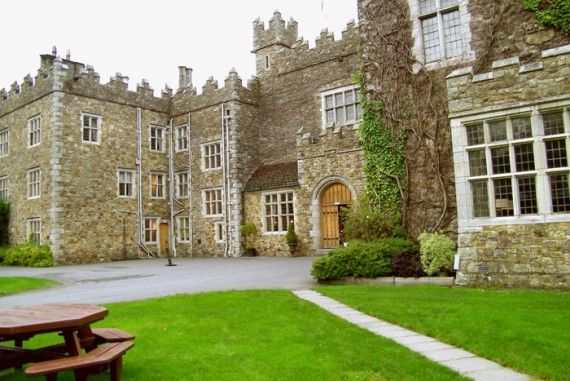
Photo Credit: Columbia Hillen/Waterford Castle
Standing one evening at the water’s edge down by the harbor, watching fishermen unloading bountiful baskets of herring, there was little doubt in our minds as to what we would be selecting for breakfast next morning.

Waterford Castle, also known as the ‘Island Haven,’ is one of the few hotels in Ireland where entrance is by ferry only; and it’s quite a thrilling way to arrive, with the lights of the imposing centuries-old building blinking in the darkness beyond. A short, beech-lined drive leads to the castle entrance. Pass the last of the trees and suddenly we were in little doubt we had entered into the annals of history.
Thick sprays of ivy decorate ancient, sturdy Portland stone walls with the majestic keep towering above, all complete with leaded glass windows and rooftop gargoyles. A formidable solid oak door stood before us and with a hefty push, my wife and I were inside a high-ceilinged room, a gigantic, open fire to the right inside the lobby, making us feel as if we had well and truly pushed back the folds of time. We half expected tall, helmeted crusaders to be standing guard at every corner.

The overall medieval ambiance is accentuated by Elizabethan oak paneling, graceful arches and a fine 16th century plaster ceiling. An Aubusson Louise Seize style wool tapestry on a fronting wall depicts an 18th century hunting scene while Victorian Jacobean style oak cabinets and a pair of George III style carved mahogany cabinets with floral festoons and rosettes adds to the décor, creating a sumptuous whole.
Indeed, castle and island are steeped in history, with no shortage of diverse tenants. From 8th century monks — as evidenced by the findings of a winged angel statue and crude carving of a monk’s head — through successive Danish and Norman invaders, to the takeover by a family from former Rhodesia who built a massive glasshouse complex here for fruits and flowers, an Irish family who concentrated on tomato growing, and an ambitious pedigree dairy farmer. Now the castle hotel is managed by the Cork-based Atlantic Hospitality Services group, which has a number of properties in its portfolio throughout Ireland.

Accommodation options are suitable for most tastes, with 19 rooms of various sizes inside the castle itself, including a Presidential suite, to a series of modern apartments on the grounds, a quarter-mile away. Having a young, lively three-year-old Irish collie with us, we chose the latter. A two-story, three-bedroom apartment awaited us at the end of a short cul-de-sac, a gas fire already lit in the living-room with a large open kitchen beside it, a case of modern comfort in the midst of an historical setting.
One of the highlights of a stay at Waterford Castle is dining in the impressive Munster room and sampling the skills of Head Chef Michael Quinn, who has held that position for the last fifteen years. Joanna Hannick, sales and marketing manager, whose many years in the hospitality industry, both in Ireland and Switzerland, began in her grandmother’s modest Mayo countryside inn, describes Quinn as a man, "who eats, reads and sleeps food."

Those seeking a beguiling medieval dining experience couldn’t ask for more — oak-paneling, an ornate oak mantelpiece and fine plaster ceiling. A slight breeze rustling the leaves outside the leaded windows added an extra sense of coziness and authenticity to the scene. Displayed decoratively on a slice of tarragon butter toast like languorous naked nymphs lingering in an open meadow, locally-sourced fresh shrimps provided the opening sensual delicacy.
But it being a windy, wet night, we felt like more weighty for our main dish so ignored the tempting seafood offerings (herrings and grilled cod for breakfast satisfied our curiosity in this regard) and launched into more hardy fare — a duo of loin Wellington, roasted haunch of wild venison and a char-grilled fillet of aged beef. The combination left us feeling we had just returned from a day’s hunting with Artemis and her cortege while an accompanying bottle of full-bodied Domain Zede Labegorce Margaux (2008) from the Bordeaux region awoke Dyonisian notions. As for dessert and our succulent lemon and rosemary panna cotta; yes, indeed, ambrosia for the Gods.

We finished our evening of culinary delight with a momentary repose in the nearby lounge, the Fitzgerald room, named after a prominent family that owned the castle from around 1160 to the mid-1900s. Among them was the formidable social leader, Mary Frances Fitzgerald, who was once engaged to the Duke of Wellington, the man who defeated Napoleon, and one of her sons, Edward, a renowned translator of Omar Khayyam’s Rubaiyat.
Here, in an intimate setting, deep-set sofas and soft lighting provide a most relaxing atmosphere, with drinks being served from a Victorian Louis Quinze cabinet in carved walnut, decorated with figural and animal panels, flower leaf scrolls, molding and beading. Around midnight, our bountiful intake of food and drinks still resting high in our stomachs, we decided to meander around the grounds by moonlight, a circular road providing easy access.
Hopped up against the crisp, autumnal air, our efforts at leisurely exercise were rewarded with a sighting of several skittish, delicate Sika deer, members of a large herd that have been introduced to this 310-acre island hideaway, no doubt enjoying as much as we this delightfully secluded sanctuary that has lain here for almost a millennium. Visit WaterfordCastle.com to learn more.

Columbia Hillen
Bare Portland stone, a giant open fireside, subdued lighting - what more could one ask for in terms of ambiance?

Columbia Hillen
Oak panelling and an 18th century hunting tapestry decorate the lobby area

Columbia Hillen
Sturdy and majestic and around for almost a millennium

Columbia Hillen
A glimpse into the past

Columbia Hillen
At your service - from a carved Victorian Louis Quinze drinks cabinet









